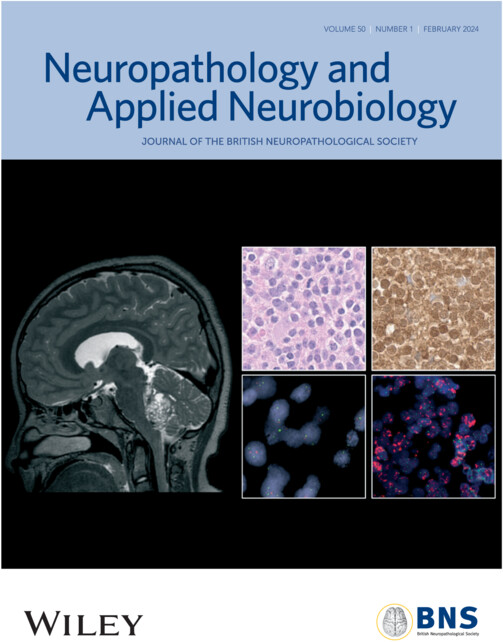γ干扰素有助于Ndufs4(-/-)利氏综合征模型的疾病进展
IF 4
2区 医学
Q1 CLINICAL NEUROLOGY
引用次数: 0
摘要
目的利氏综合征(LS)是儿科最常见的遗传性线粒体功能障碍,是一种多系统疾病,以严重的神经和代谢异常为特征。脑干对称性、双侧进行性坏死是该病的显著特征。患者早期通常无症状,但一般在 2 岁左右出现症状。LS的发病和进展机制仍不清楚。最近的研究表明,在Ndufs4(-/-)LS小鼠模型中,免疫系统是疾病的诱因:用抑制巨噬细胞的Csf1r抑制剂pexidartinib治疗Ndufs4(-/-)小鼠可预防疾病。虽然导致免疫激活的确切机制和参与疾病进展的免疫因子尚未确定,但研究发现γ干扰素(IFNγ)和γ干扰素诱导蛋白10(IP10)在Ndufs4(-/-)脑干中显著升高,这表明这些因子与疾病有关。在此,我们旨在探讨IFNγ和IP10在LS中的作用。方法为了确定IFNγ和IP10在LS中的作用,我们产生了IFNγ和IP10缺失的Ndufs4(-/-)/Ifng(-/-)和Ndufs4(-/-)/IP10(-/-)双基因敲除动物,以及IFNγ和IP10杂合的Ndufs4(-/-)/Ifng(+/-)和Ndufs4(-/-)/IP10(+/-)动物。我们监测了疾病的发生和发展,以确定IFNγ和IP10的杂合或同源缺失对LS的影响。IFNγ的缺失以基因剂量依赖性的方式明显延长了生存期并延缓了疾病的进展,尽管与Csf1r抑制相比,其益处不大。我们的研究结果表明,IFNγ靶向疗法可能会给遗传线粒体疾病带来一些益处,但单独靶向 IFNγ 可能只会给 LS 带来适度的益处。本文章由计算机程序翻译,如有差异,请以英文原文为准。
Interferon‐gamma contributes to disease progression in the Ndufs4(−/−) model of Leigh syndrome
AimLeigh syndrome (LS), the most common paediatric presentation of genetic mitochondrial dysfunction, is a multi‐system disorder characterised by severe neurologic and metabolic abnormalities. Symmetric, bilateral, progressive necrotizing lesions in the brainstem are defining features of the disease. Patients are often symptom free in early life but typically develop symptoms by about 2 years of age. The mechanisms underlying disease onset and progression in LS remain obscure. Recent studies have shown that the immune system causally drives disease in the Ndufs4 (−/−) mouse model of LS: treatment of Ndufs4 (−/−) mice with the macrophage‐depleting Csf1r inhibitor pexidartinib prevents disease. While the precise mechanisms leading to immune activation and immune factors involved in disease progression have not yet been determined, interferon‐gamma (IFNγ) and interferon gamma‐induced protein 10 (IP10) were found to be significantly elevated in Ndufs4 (−/−) brainstem, implicating these factors in disease. Here, we aimed to explore the role of IFNγ and IP10 in LS.MethodsTo establish the role of IFNγ and IP10 in LS, we generated IFNγ and IP10 deficient Ndufs4 (−/−)/Ifng (−/−) and Ndufs4 (−/−)/IP10 (−/−) double knockout animals, as well as IFNγ and IP10 heterozygous, Ndufs4 (−/−)/Ifng (+/−) and Ndufs4 (−/−)/IP10 (+/−), animals. We monitored disease onset and progression to define the impact of heterozygous or homozygous loss of IFNγ and IP10 in LS.ResultsLoss of IP10 does not significantly impact the onset or progression of disease in the Ndufs4 (−/−) model. IFNγ loss significantly extends survival and delays disease progression in a gene dosage‐dependent manner, though the benefits are modest compared to Csf1r inhibition.ConclusionsIFNγ contributes to disease onset and progression in LS. Our findings suggest that IFNγ targeting therapies may provide some benefits in genetic mitochondrial disease, but targeting IFNγ alone would likely yield only modest benefits in LS.
求助全文
通过发布文献求助,成功后即可免费获取论文全文。
去求助
来源期刊
CiteScore
8.20
自引率
2.00%
发文量
87
审稿时长
6-12 weeks
期刊介绍:
Neuropathology and Applied Neurobiology is an international journal for the publication of original papers, both clinical and experimental, on problems and pathological processes in neuropathology and muscle disease. Established in 1974, this reputable and well respected journal is an international journal sponsored by the British Neuropathological Society, one of the world leading societies for Neuropathology, pioneering research and scientific endeavour with a global membership base. Additionally members of the British Neuropathological Society get 50% off the cost of print colour on acceptance of their article.

 求助内容:
求助内容: 应助结果提醒方式:
应助结果提醒方式:


